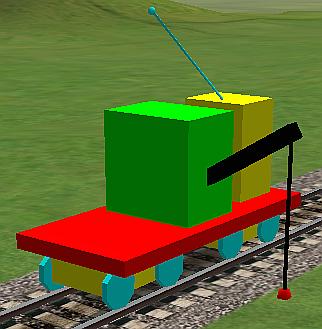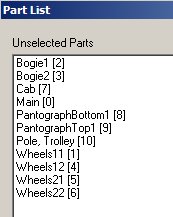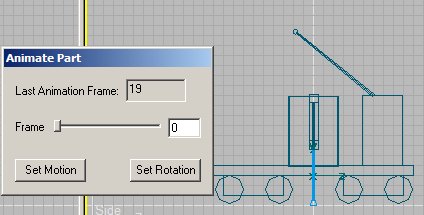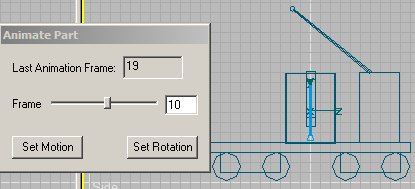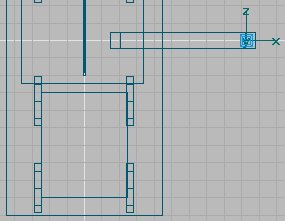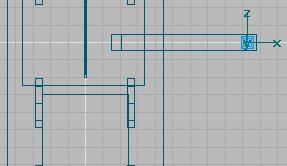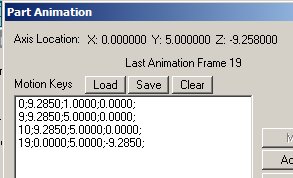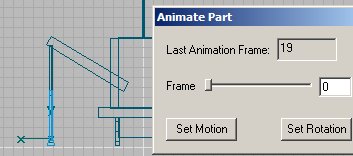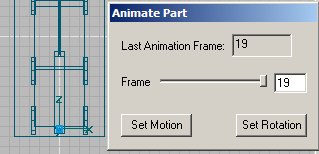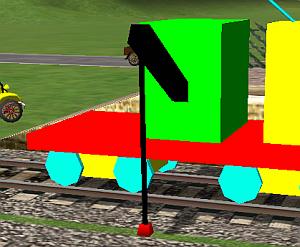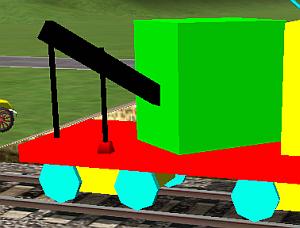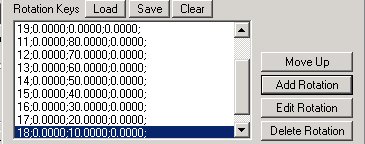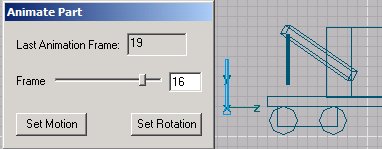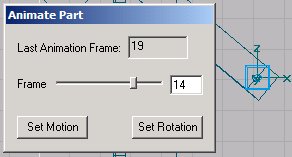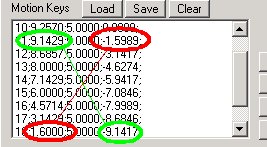Let's start off by constructing a body, perhaps 9 feet wide, 20 deep, and 1 high. I have colored it red. This we will name Main. You will need to move the Main up above the origin about 3 feet. Then you will have to move the axes of Main back down to the origin - remember constrain x and z, hold down SHIFT, and use the Move Tool to do the necessary. It probably makes sense to texture it now, so do so. The next item will be a wheel. You will want it to be less than 3 feet in diameter, so it will fit under the Main, and onto the top of the track, which will be at the origin. A nice wheel diameter is 33 inches, so do the math, and use the Tube Tool to make a disc that has a radius of 16½ inches or 1.375 feet, a width of say 4 or 5 inches, 8 points, closed at both ends, and structured on the x axis. Then use the Move Tool to move it to the front of the Main, and over one of the tracks. Texture it now - I colored mine turquoise.
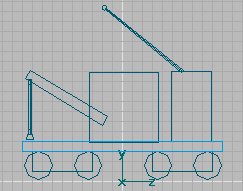
Next you will need a Bogie, so build a cube with the Box Tool that fits under the Main, between the tracks, and perhaps 6 feet long. Move it up under the Main, and color it yellow. Now for housekeeping, you will have to use a Train Name, Bogie1. Set the Part Parent as Main.
Copy Bogie1, and then Paste. Then move the pasted part back toward the rear. If you will look in the Part Properties for Bogie1 you will see that the z axis is approximately 6. So, open the Part Properties for the pasted part, and change its name

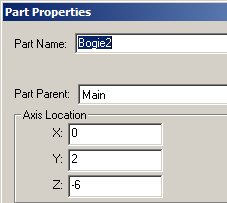
to Bogie2, then change the z axis to read approximately -6. This will result in the two Bogies being equally spaced under the Main. And they both have the correct Part Parent and are both already textured.
Now go back to the wheel and again copy and paste, then move the pasted wheel over to be on top of the opposite track. You could also add an axle, but we don't need one for this exercise. Now select either of the wheels, and press the spacebar so it changes color in TSM. Then move to the other wheel and press the spacebar again, and then press J to join the two wheels into one part. Go to Part Properties and change the name of the combined wheels to a Train Name, namely Wheels11. Since the first wheel was already textured, both should be now, automatically. Set the Part Parent to Bogie1.
Generate Wheels12 by copying and pasting Wheels11, and moving the pasted set back on Bogie1. Rename the pasted wheels as Wheels12. Do the same thing for Wheels21 and 22, putting them under Bogie2, and setting the Part Parent to Bogie2 for each. We have finished parts 0 through 6. We need a Cab for the Motorman, so build a box about 5 feet wide, 7 high, and 4 deep, move it to the front of Main, perhaps a foot from the front edge, and sink it into the Main just a bit. I then was able to delete the un-needed bottom poly of the Cab, and colored the remainder yellow. Again set the parent.
The next order of business is to build the Crane Body, Boom and "part of the Cable". What these parts will do is to simply rotate on top of the Main. Since they are to be animated they will need a Pantograph Train Name, and since they will be moved together they may as well end up being a single part. That is what we will do. You may wonder about the "part of the Cable" - and that is one clever trick. What we are going to have is telescoping parts, because I know of no way to make a flexible part that will roll up on a winch reel.
So use the Box tool to make a suitable Crane Body, perhaps 5 feet wide, 7 deep and 7 high. Move it to a position on the top of the Main, approximately in the center. Place the axes in the center of the Body. For the moment call it Body, delete the unseen bottom poly, set the Part Parent as Main, and texture it green. Then create a Boom say 1 foot square in cross-section and 9 feet long. Move it up and into the Body, and angled at some appropriate angle. Delete the poly that is embedded in the Body, and texture the remainder black.
Now for the "part of the Cable", measure the distance that you estimate will be the maximum from the bottom of the Boom, where the Cable will appear to come out, to the ground. I figured about 10 or so feet. So, using the Tube Tool, create a 4-sided tube, approximately 0.1 feet square and 5 feet high, and arrange it to hang vertically from the upper end of the Boom. The top portion will be buried in the Boom, so it does not need a top poly, and the bottom portion will have a similar Cable telescoped into it, so it may likewise be devoid of a poly. For the moment, call it Cable Top, and texture it black. Now select the Cable Top, and press the spacebar, then select the Boom and again hit the space bar, and finally select the Body, and again hit the spacebar; then hit J to join all three parts together. Go to Part Properties, and you should find you have a part named Body, whose Part Parent is Main. If not, then you have joined the 3 parts out of order, and the axes will be somewhere other than the center of the Body. If that is the case, you know how to move the axes, so do so to get then in the center of the Body. Go to Train Names and from the drop down list pick a Train Name that the P key will recognize, such as PantographBottom1. Make sure the Part Parent is Main.

Now would be a good time to set up the Project Properties, so let's do that.
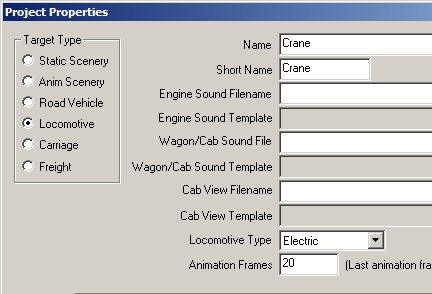
This time I have chosen 20 Animation Frames, mostly to slow the resultant animation down somewhat. We now have a choice: we can either animate what we have so far, or we can build the remaining parts, and then do the animation. Since we are on a roll with the part building, lets finish that up first.
The next part will consist of the Cable Bottom and the Weight at the bottom. You recognize the Weight could be a hook, electromagnet, or some other simulated load. First, make the Cable Bottom, which will be the same as the Cable Top. Texture it black, and place it so that it is telescoped into the Cable Top, and perhaps 6-8 inches above the floor of Main. Then build a Weight of whatever size looks right, put it into and under the Cable Bottom, just off the floor of the Main, and color it red. Now select these two items and join them together. Then go to Part Properties, and change the Part Name to one of the Pantograph Train Names, e.g. PantographTop1.
For our final part, construct a Trolley Pole using the Tube Tool. It may be relatively small in diameter, and have 3 or 4 points, 1 section, and open at both ends. A length of 10 feet ought to do. Angle the Trolley Pole out of the roof of the Cab. Then build a small trolley wheel to go on top - maybe 6 inches in diameter and 2 inches thick, with 6 points. Select both and join them together to make one part. Texture them, I chose turquoise. If you like, go into Part Properties and click Polygon Smoothing. Select a Part Name in Part Properties and you are all done making parts.
